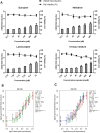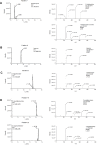Bioassay-directed analysis-based identification of relevant pyrrolizidine alkaloids
- PMID: 35610518
- PMCID: PMC9217854
- DOI: 10.1007/s00204-022-03308-z
Bioassay-directed analysis-based identification of relevant pyrrolizidine alkaloids
Abstract
Pyrrolizidine alkaloids (PAs) are produced by various plant species and have been detected as contaminants in food and feed. Monitoring programmes should include PAs that are present in relevant matrices and that exhibit a high toxic potential. The aim of the present study was to use a bioassay-directed analysis approach to identify relevant PAs not yet included in monitoring programmes. To that end, extracts of Heliotropium europaeum and H. popovii were prepared and analysed with LC-MS/MS for the presence of 35 PAs included in monitoring programmes, as well as for genotoxic activity in the HepaRG/γH2AX assay. Europine, heliotrine and lasiocarpine were found to be the most abundant PAs. The extracts showed a higher γH2AX activity than related artificial mixtures of quantified known PAs, which might point to the presence of unknown toxic PAs. The H. europaeum extract was fractionated and γH2AX activities of individual fractions were determined. Fractions were further analysed applying LC-Orbitrap-MS analysis and Compound Discoverer software, identifying various candidate PAs responsible for the non-explained genotoxic activity. Altogether, the results obtained show that bioassay-directed analysis allows identification of candidate PAs that can be included in monitoring programmes.
Keywords: Bioassay; HepaRG cells; LC-MS/MS; LC-Orbitrap-MS; Pyrrolizidine alkaloids; γH2AX assay.
© 2022. The Author(s).
Conflict of interest statement
The authors declare that they have no conflicts of interest.
Figures







References
-
- Alhusainy W, Paini A, Punt A, Louisse J, Spenkelink A, Vervoort J, Delatour T, Scholz G, Schilter B, Adams T, van Bladeren PJ, Rietjens IMCM. Identification of nevadensin as an important herb-based constituent inhibiting estragole bioactivation and physiology-based biokinetic modeling of its possible in vivo effect. Toxicol Appl Pharmacol. 2010;245:179–190. doi: 10.1016/j.taap.2010.02.017. - DOI - PubMed
MeSH terms
Substances
Grants and funding
LinkOut - more resources
Full Text Sources

